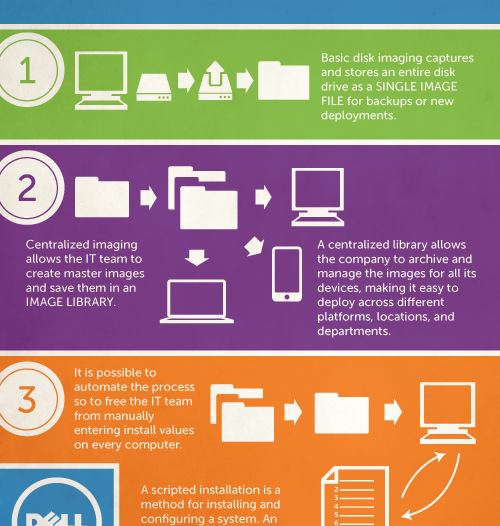
Guest Post:
by Matt Obrien, Dell Kace
Sitting through one installation after another is not themost cost-effective activity for the IT department, which is why many organizations are turning to other methods to install operating systems, drivers, and applications on new computers or when restoring an older device. These companies adopt a standardized software deployment system that captures the disk image as an image file where it can be edited, organized, and deployed to new or repurposed computers. This is where Disk Imaging and Deployment becomes essential.
Basic Disk Imaging and Deployment
A disk image is a file-by-file copy of a computer’s hard drive, which is saved in one or more image files. These files can be saved to a network, burned to a DVD, or sent to another storage device for further use. This image replicates the entire structure and contents of the hard disk, which can then be used to install operating systems on new computers and set up the necessary applications or to restore damaged systems.
This image lets the IT team set up every computer in a department or organization without having to install the individual components on every system. If the company has a large number of departments and devices, though, the number of images can start to get out of hand. In order to avoid some of the impending issues that can arise for this, many companies employ solutions for effective management.
Centralized Imaging
The images created in this process can be used as a baseline installation for a lot of the normal, everyday, technical needs of the company because they have the basic setup and all the associated patches, applications and programs ready to go. The IT team will still need a way to access all the information when necessary and deploy the right disk imaging to the right device.
By uploading everything to a centralized “image library” the team will be able to archive and manage all their images and easily deploy, edit and maintain them. Different departments may require completely different operating systems and applications, and this allows the IT team to provision everything (even to remote users) from a single, centralized console.
Scripted Installations
Installing and configuring all these systems can be very time consuming, and there are more cost-effective things the IT department could be doing. Scripted installs allow the IT team to install operating systems and applications and even configure the settings without having to sit in front of every computer and manually enter the necessary installation values.
When disk images are deployed from a centralized location, it is possible to use an answer file to respond to all the installation questions and completely automate the process. No one needs to sit in front of a computer for extended periods just to click “Yes” or “No” occasionally. The answer file provides the script for running these installations so the IT department can move on to other tasks while still deploying the necessary installations on each system.
Author Matt Obrien.
Matt works with Dell Kace. He enjoys writing about technology, computers and saving money.